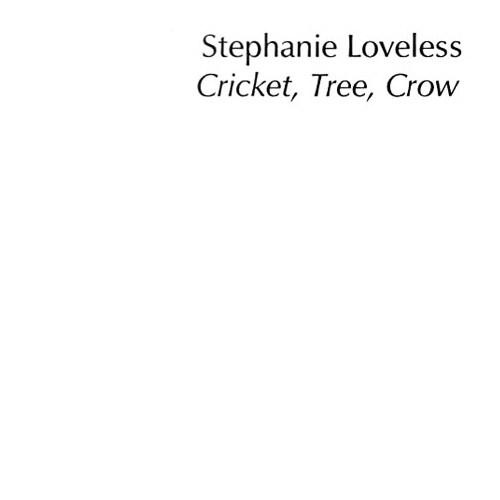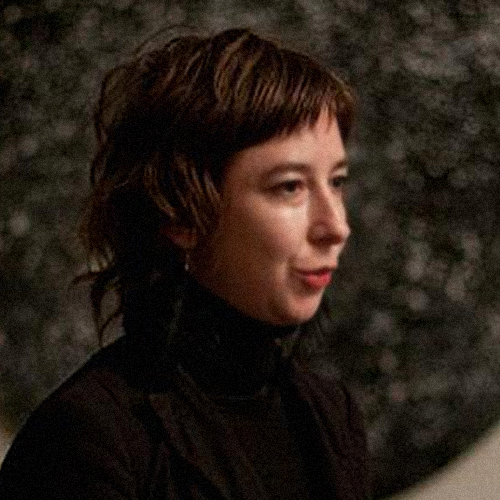Cricket, Tree, Crow
STEPHANIE LOVELESS
(Audience Editions 2013)
Review by Chris Whitehead
Cricket, Tree, Crow is a DVD containing two versions of the composition: An uncompressed stereo mix and a compressed 4.0 DTS surround DVD. Due to a lack of the necessary technology, this review is of the stereo version.
The first thing to say about Stephanie Loveless’ Cricket, Tree, Crow, is that it contains no field recordings whatsoever. Instead it is made up of Stephanie ‘s vocalised reconstitutions of field recordings, which are in turn informed by deep listening to recordings made in nature. As a self confessed city dweller surrounded by the built, the broadcast, the electronically reproduced and the wholly human, connection with other forms of life, particularly their secret languages, was something she decided to address.
Cricket, Tree, Crow is a short (18 minutes) recording consisting of three movements in which Stephanie has layered and processed her vocals, often using extended techniques and utilising all the rattles, scrapes, croaks and drones that hide away in the human voice. Things we rarely use in speech or singing are pushed forward to create a pre-verbal, primeval choir of phantom voices, a ghost chorus.
As David Dunn, Director of the Art and Science Laboratory in Santa Fe, puts it in his illuminating essay (Voices of the Others: A Few Considerations for Listening to Cricket, Tree, Crow) that accompanies this release: “This kind of sensory empiricism is similar to what humans must have always done to commune with and – in some sense – acquire ‘non – human language’ as a way to counteract the power of the external environment, share resonance with these other living systems, and give credence to an experience of a greater collective mind.”
Cricket begins with a rising mist of chirruping and summer heat rhythmically layered over constant Orthopteran chatter. Recreating the familiar with the strangeness of dislocation produces an eerie meta-world. There are no environmental sounds in the background. The rustling of dry grass, a passing bee or a plane overhead would have located this work in reality, but instead it is isolated and preserved like a pinned out butterfly.
Stephanie occasionally takes a breath, and the human based engine behind this reproduction of nature becomes suddenly apparent. To reiterate, rather than being a pinned out butterfly, this is more like an artist’s rendering of a pinned out butterfly. It is hyperreal, clearer and more brightly coloured. A memory of nature as something that is trying to communicate with us, something we maybe once were.
At first the wind that shifts the branches in Tree is a purely hypothetical catalyst for movement rather than the physical transition of air. We are concerned here with the straining fibres of huge Maple trees and the frictional abrasion of branches rubbing together. The rhythms are those of monumental things, creaking and dense. Stephanie’s voice rasps over itself and maps out extended skirls of collective timber groans. Later we seemingly move further into the upper limbs where leaves rustle and the breeze becomes breath.
Crow brings a metallic, frightening talon of a voice scraping across the tympanic membrane. For me crows and their corvid kind are the sound of the redness in tooth and claw that underpins nature. They are the sound of the celluloid, rural England of Witchfinder General and Blood on Satan’s Claw. One is of course the cursed conveyor of the word ‘nevermore’ in Edgar Allan Poe’s doom laden poem The Raven.
Unlike the previous two sections, Stephanie is actually performing the language of another creature here, as the sound of the crow is its actual voice. The cricket communicates by rubbing its legs together and the tree through the agency of wind, but the crow brings its cawing up from within the body and out into the air. Like a choir of reincarnated souls these sit and call from trees, puncturing the daylight with their embodiment of night, or they cry and take to the sky en masse in a black cloud.
So the artist has stripped back the encumberence of words and locked into a purity of expression informed by the song of the environment. She has then recreated this world as perfectly as possible using an imperfect tool, the human voice. At once unsettling, dislocating, brave and fascinating, Cricket, Tree, Crow is without doubt a unique addition to the documentation of the tension between man and those whose planet we share.
[Stephanie Loveless]



